
|
|

January 20, 2006
KFI, Los Angeles, California
By SCOTT FYBUSH
Welcome to a new year of Tower Site of the Week! We're kicking off right where we left off - in the nation's number-two radio market (number one if you count by revenue, as the locals prefer to do), Los Angeles, California.
This week, we feature our April, 2005 visit to one of the saddest sights in the broadcast world, a major transmitter site without its tower. On December 19, 2004, KFI's 750-foot main tower was hit by a single-engine Cessna 182 on approach to nearby Fullerton Airport, killing the pilot and his wife and destroying the tower.
You can see plenty of photos of the immediate aftermath on Barry Mishkind's oldradio.com site, at Paul Sakrison's site, and at Steve Blodgett's earthsignals.com. What we offer here is a look inside the transmitter building, a bit of history, and the more long-range aftermath of the tragedy.
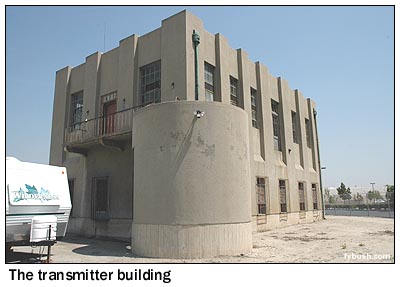
|
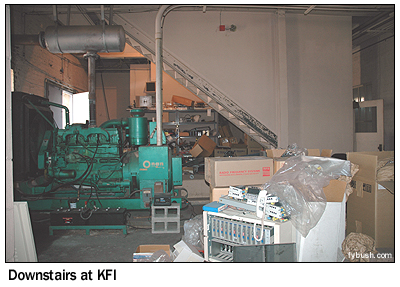
|
First, of course, the history: this site, just inside the Los Angeles County line in La Mirada (it's often referred to as "Buena Park," the neighboring Orange County community), dates back to 1931, when KFI moved here from the Packard Building in downtown Los Angeles and boosted power from 5,000 to 50,000 watts. The transmitter was an RCA 50B, a behemoth that covered parts of two walls of the upstairs transmitter room, in an "L" configuration. As with most high-powered transmitter buildings of the era, the bulky power transformers were located downstairs, and today visitors enter the building through the side door, into the first-floor room where those units once sat.
These days, aside from the backup generator, the downstairs room is used largely for storage, and if it looks a little messy, it's only because it wasn't that long ago that KFI's engineers completed the station's move from the Koreatown studios it had occupied for three decades into the new Clear Channel complex in Burbank.
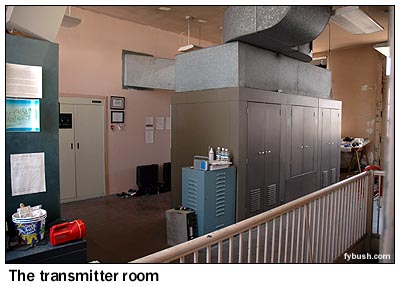
|
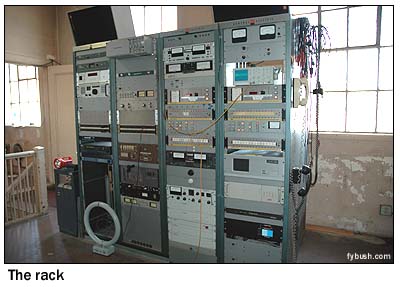
|
The stairs in the background of our first-floor photo lead right up to the transmitter room, where at one time visitors would have emerged to find the big RCA filling the room right in front of them. The RCA was supplanted by a Continental 317B in 1959, and was retired completely in the mid-seventies when a Continental 317C was put in place. Today, the 317C backs up to the stairs (it's the big brown box on the right side of the frame), and a Harris DX50, installed in 1992, occupies one of the walls where the RCA once sat. The other wall is now home to a big rack of processing and monitoring gear, including the newest addition to the site, the BE IBOC exciter that was put into place just a few months before the tower collapse. (Since the collapse, the IBOC has been off the air; the auxiliary tower that KFI now uses with 25 kW doesn't load up well with IBOC.)
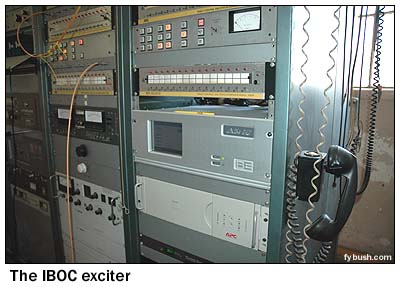
|
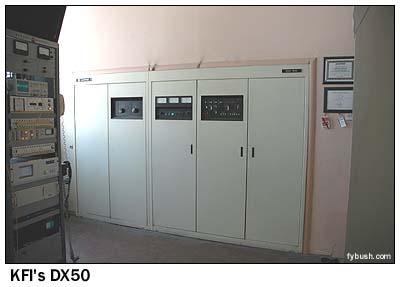
|
As you'd imagine for a site with this much history, there are all sorts of great stories about some of the doings here in the last 75 years. For instance, there's a mysterious box that now sits on a table at the back of the transmitter room that was once used to modulate a very-low-frequency data signal on the KFI signal. What was it used for? That's a government mystery, even now - and it's been many years since the teletype signals came across to La Mirada from wherever it was they came from, carrying the data that was to be broadcast to whoever it was listening, wherever they might have been.
Then there was the wartime security at the site, which was considered a pretty major target for enemy action after Pearl Harbor. Searchlights were set up on the roof, and armed guards were stationed at the site 24/7 for a while, bunking in a converted section of the garage behind the transmitter building. One day - or so the story goes - one of the guards was in the shop next to the transmitter room when something startled him and he discharged his rifle, right into the ceiling. That's where that hole shown below came from, as legend has it.
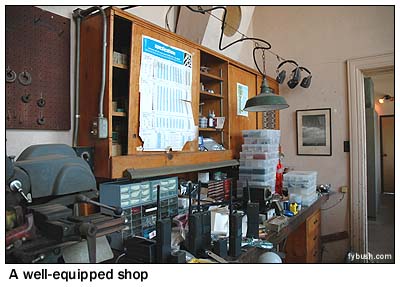
|
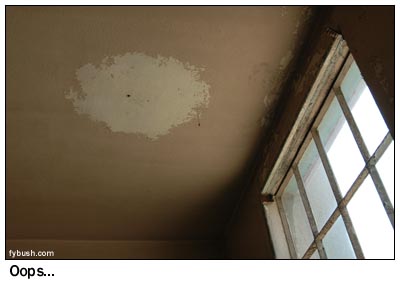
|
The shop leads around to the office at the front of the building, a very pleasant sunlit space with beautiful wooden furniture that would probably cost a fortune to replace today. From here, the old front door leads out to the balcony and the spiral staircase, enclosed in a big concrete cylinder, that was once the main entrance to the building. (It was condemned some years back, and is now gated off.)
The decorative tilework around the front door is a sight to behold, with the big "K F I" letters above the door and tiles on either side showing a sort of Southwestern Deco representation of a radio tower emitting radio waves. (Wish I could decorate my house with those...)
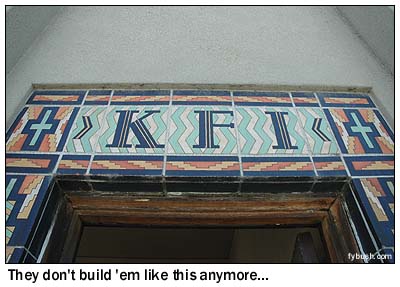
|
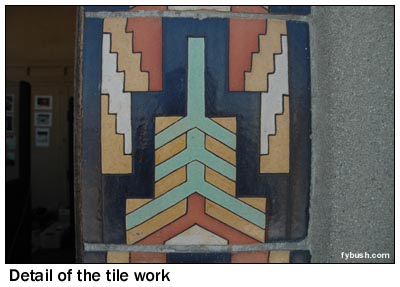
|
Heading back inside and through the office, there's still one more room to see on the second floor: a smallish room that's now used as a point of entry for the telco lines that connect the transmitter site with the Burbank studios.
(And don't you just love that enormous theater speaker perched up on the cabinets overhead?)
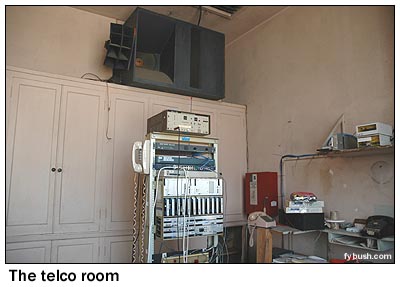
|
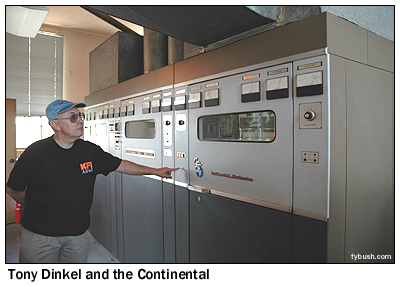
|
So far, of course, our tour has looked pretty normal - these are all elements of a normally-functioning radio station with a long, proud history, right down to the L-shaped marks on the floor that show where the RCA once sat, and the holes in the floor that still show evidence of where the control wiring once came up for the console that controlled the mighty beast. (Barry's got some great pictures of the old RCA, also at his oldradio.com site.)
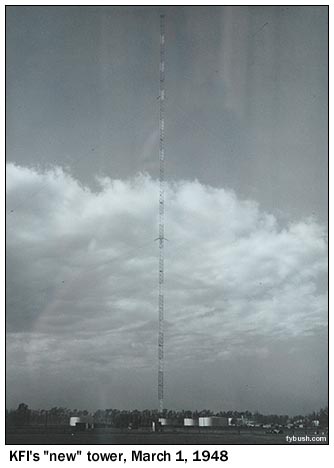
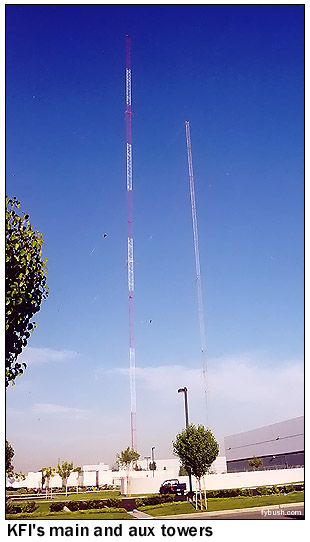 But after seeing
the inside of the building, it's time to turn our attention to
the outside of the building - and to see firsthand where the
big tower was, and what happened when it came crashing down that
fateful Sunday morning.
But after seeing
the inside of the building, it's time to turn our attention to
the outside of the building - and to see firsthand where the
big tower was, and what happened when it came crashing down that
fateful Sunday morning.
Again, some history: when the La Mirada site was built in 1931, it used a horizontal wire antenna supported by two 400-foot towers straddling the transmitter building.
As the science of medium-wave transmission improved, those early wire antennas gave way to tall vertical antennas. KFI was, I believe, the last of the big 50 kW clear channel stations to abandon its horizontal antenna. In the fall of 1947, construction work began on a half-wave (750-foot) Ideco steel tower behind the transmitter building, and in early 1948 the old towers were dropped and transmissions moved to the new tower. (The photo that hangs on the wall of the KFI shop, and which is shown above, is dated March 1, 1948.)
The landscape around that tower changed dramatically in the nineties, as the land around the KFI site turned from orange groves into industrial parks. Today, I-5 runs just a couple of blocks from the KFI site, and the surrounding area is thick with car dealerships, fast-food restaurants and warehouse buildings. Under Cox ownership, inspired by the development of the land surrounding the tower of then-sister station WSB in Atlanta, the open land around KFI's main tower and its 200-foot auxiliary tower was covered with warehouses in the mid-nineties, with the transmitter building confined to a little patch of land on one corner of the property and tall circular concrete-block walls surrounding the tower bases and the guy wire anchors. The photo above at right, taken in 2001, shows how tightly the area around the tower was packed by then.
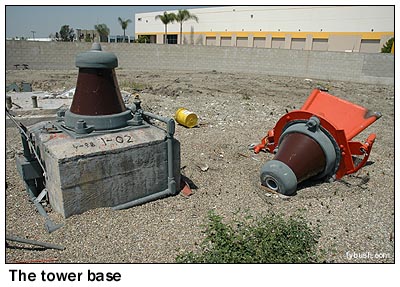 |
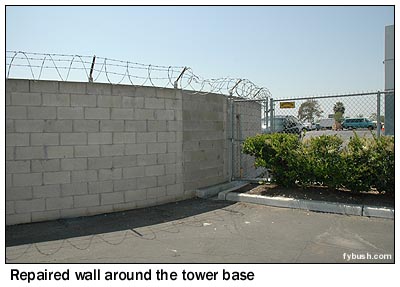
|
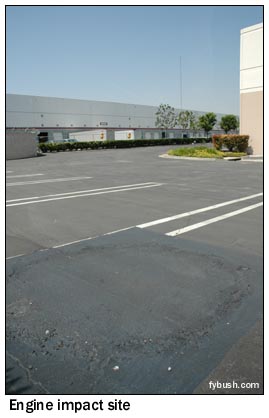
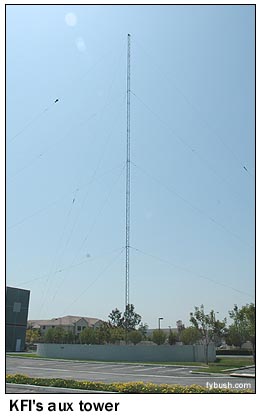 It is remarkable,
then, that the collapse of this giant tower did so little damage.
It is remarkable,
then, that the collapse of this giant tower did so little damage.
When it came down, the tower structure itself did precisely what it was designed to do - it folded in on itself twice, creating a sort of "Z" shape of tangled steel that landed largely within the concrete-block wall that surrounded the tower base, protruding at only two points into the adjacent parking lot.
(The areas where the falling tower crushed the wall were repaired fairly quickly after the tower pieces were removed, and today show as slightly discolored areas of the wall.)
Only a few months earlier, the original 1948 guy wires had been removed and replaced, and it was those flying guy wires, as they pulled loosed from the anchors that held them to far corners of the property, that did what little damage was done.
In several areas of the site, you can see the marks made on the pavement as the guy wires scraped across them, and there was one corner of a warehouse roof that took an impact from a guy wire as it came down, though the damage was minor. There were also several trailers on the property that were damaged by flying guy wires. (It's fortunate indeed that the collapse happened on a Sunday morning, when the warehouse park is quiet and largely deserted; there could well have been more injuries, and certainly more vehicular damage, had the crash taken place on a busy weekday.)
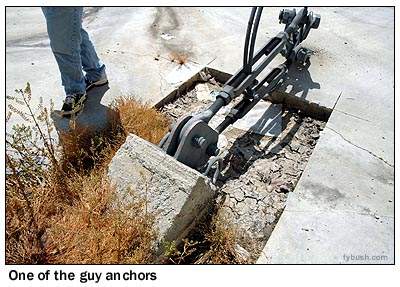 In
the photo at right, you can see some of the pavement markings
made by the guy wires as they came loose from the anchors, which
will almost certainly need to be replaced as the tower is rebuilt.
(More on that in a moment.)
In
the photo at right, you can see some of the pavement markings
made by the guy wires as they came loose from the anchors, which
will almost certainly need to be replaced as the tower is rebuilt.
(More on that in a moment.)
The Cessna itself landed at something of a distance from the tower, at the far end of a parking lot two buildings away from the tower base. That patch of repaired pavement shown above is where the engine slammed into the ground, creating a fairly deep pit.
Within an hour or so of the impact, KFI was back on the air, running at half-power into the short auxiliary tower at one corner of the property. For more than a year now, that little stick has been KFI's lifeline to the world, and that's unlikely to change right away.
Clear Channel (which has owned KFI since 2000) hopes to rebuild the tower right where it stood, avoiding all the problems that would come from attempting to relocate this huge signal (especially a tight allocations situation brought about by the presence of third-adjacent KIRN 670 in Simi Valley), but the regulatory hurdles - and in particular, the presence of Fullerton Airport nearby - are immense. If all goes well, sometime in 2006 the permissions will be granted. For a little while, KFI will fall silent from La Mirada, moving its transmissions to the old 1150 site in Montecito Heights at reduced power. And then, we can hope, a tall tower will once again sit here next to I-5, carrying the big signal on 640 out to the West and beyond.
- Previous Site of the Week: Mount Wilson, re-re-revisited, part II
- Next Week: KTNQ and KTLK, Los Angeles
- Site of the Week INDEX!
- How can you help support Site of the Week? Click here!
- Submit your suggestions for a future Site of the Week!
